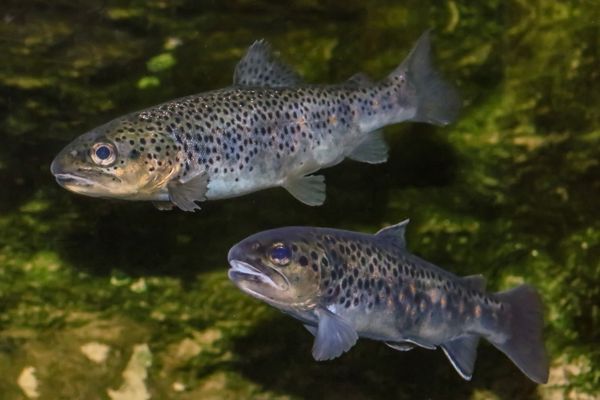Before I can answer this question, I first need to state that the ‘word’ trout can refer to many different species and groups of fish. Many are very distantly related.
But, for the vast majority of people, the word trout is an English name for members of the Salmonidae family of fish that inhabits the temperate regions of the Northern Hemisphere (but has been introduced well outside of their natural range).
In this article, (and this website in general) when I refer to trout I am referring to the members of the Salmonidae family of fish.
The most well known Salmonidae trout groups include Rainbow trout, Brown trout, and brook char. Although, there are many more lesser known variations within these main groups but that is a topic for another time.
Saltwater fish that are called trout but are not
Salmonidae trout should not be confused with the numerous other types of fish that have been given the name ‘trout’ but which belong to entirely different families.
One such example is the Spotted Seatrout (or speckled trout) which is an estuarine species belonging to the family Sciaenidae. Spotted Seatrout natural range is along the Atlantic coast south of Maryland and into the Gulf of Mexico They are an entirely different type of fish.
It gets even more confusing because the same ‘common’ names can refer to a genuine type of trout and an entirely different species of fish. One example is Marble Trout, which usually refers to the Brown trout variant (Salmo marmoratus) found in Northern Italy and the Balkans, but it can also apply to Aplodactylus arctidens which is a little known reef fish that lives off the New Zealand coast.
In the western Pacific, around Australia there is also a tropical fish known as the Common Coral Trout, Leopard Coral rout but more typically Leopard Coral Grouper. Again, this is of no relation to the Salmonidae species of trout. They also have a ‘Salmon’ in Australia which is of no relation to any of the Salmonidae species of salmon.
I could go on, but I think I have made the initial point, that the common word ‘trout’ has been used in the naming of a vast number of different diverse species of fish.
The direct answer
All trout (Salmonidae) start their lives in freshwater, but some do migrate out to sea to feed and put on condition, but they always return to freshwater to spawn and lay their eggs.
So are trout saltwater fish, well no. But they can spend part of their life out at sea.
Probably the best known sea run (or Anadromous) trout are Steelheads. Steelheads are rainbow trout that decided to leave their homes in the rivers and lakes and enter the marine environment with the intention to feed and put on condition.
At times, river resident rainbow trout can get washed out to sea by large floods, I do not consider such trout to be steelheads because they are following the freshwater, and I can only assume they quite promptly return to the rivers to avoid the encroaching saltwater.
In Northern Europe, and to a much lesser degree in North America some Brown trout also decide to become sea run. Just like the Steelheads, they live the rivers to feed in the richer marine environment.
All species of trout, when they become Searun seem to go through a phenological transformation. Their scales typically become more silver and their spots fade.
Now, there are exceptions. I once caught a brown trout off a surf beach nearly a mile from the nearest river. That trout was as ‘brown’ as any river resident fish I have ever caught. A real enigma, I can only assume it had been living in a nearby tidal estuary and only recently ventured out to sea.
How long does is take trout to acclimatize to saltwater?
Firstly, trout have to reach a reasonable size before they migrate to the ocean. If they are too small, they struggle to handle the differences in salinity between fresh and saltwater.
So usually sometime between their 2nd or 3rd year of life, they start their migration out to sea.
Trout can acclimatize to life in saltwater quite quickly, and it is actually possible for trout to survive being transferred directly from freshwater to seawater without an intermediate period in brackish water (that is how many rainbow trout farms at sea operate). Once in the sea, the trout acclimatization over a period of about a week with larger fish acclimatizing faster.
When wild trout have the option, they do seem to prefer to spend a couple of weeks in brackish estuarine water rather than heading directly out to sea.
The return to freshwater occurs even more rapidly, with an acclimatization period of less than 5 days being recorded for Brown trout.
Brown trout often only spend 3-4 months at sea before returning to the river, although the occasional trout does over winter.
This is quite the contrast to Steelhead which typically spends several years out at sea to put on condition before migrating back to the river for spawning. Mature repeat spawners, usually return to the river sooner, sometimes within 3-4 months of leaving the river for their second time.

